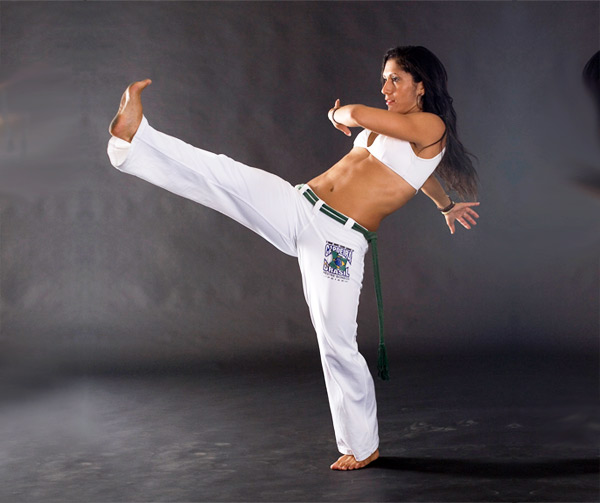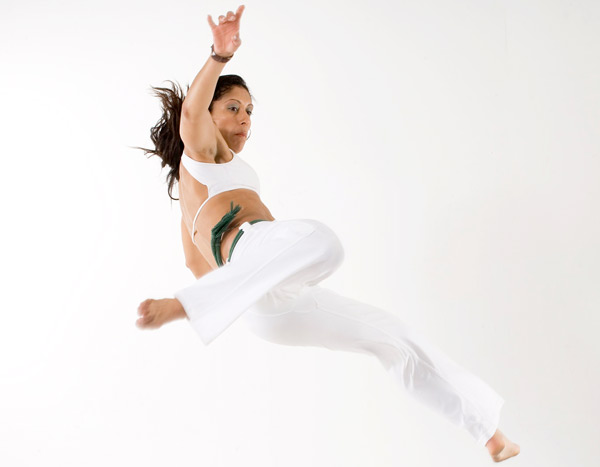
Capoeira is a Brazilian martial art that combines elements of dance, acrobatics and music, and is sometimes referred to as a game. It was developed in Brazil mainly by West African descendants with native Brazilian influences, probably beginning in the 16th century. It is known for quick and complex moves, using mainly power, speed, and leverage for a wide variety of kicks, spins, and highly mobile techniques.
The most widely accepted origin of the word capoeira comes from the Tupi words ka’a (“jungle”) e pûer (“it was”), referring to the areas of low vegetation in the Brazilian interior where fugitive slaves would hide. Practitioners of the art are called capoeiristas. On 26 November 2014 capoeira was granted a special protected status as “intangible cultural heritage” by UNESCO.
Capoeira’s history begins with the beginning of African slavery in Brazil. Since the 17th century, Portuguese colonists began exporting slaves to their colonies, coming mainly from West Africa. Brazil, with its vast territory, received most of the slaves, almost 40% of all slaves sent through the Atlantic Ocean.
The early history of capoeira is still controversial, especially the period between the 16th century and the beginning of the 19th century, since historical documents were very scarce in Brazil at that time. But oral tradition and evidence leaves little doubt about its African roots. Each group tends to have their own specific views on the history of capoeira.
Those such as Abada and Cordao de Ouro view the art form as a Brazilian art form while certain “angoleiros” such as Mestre Moraes, view the art as purely African. Other groups, such as Senzala de Santos, view the art form as a combination of not only African and Brazilian, but Native American too.
Capoeira nowadays is not only a martial art, but an active exporter of Brazilian culture all over the world. Since the 1970s, capoeira mestres began to emigrate and teach it in other countries. Present in many countries on every continent, every year capoeira attracts to Brazil thousands of foreign students and tourists. Foreign capoeiristas work hard to learn Portuguese to better understand and become part of the art. Renowned capoeira mestres often teach abroad and establish their own schools. Capoeira presentations,
normally theatrical, acrobatic and with little martiality, are common sights around the world.
The martial art aspect is still present and still disguised, leading many non-practitioners to ignore its presence. Trickery is ever present and expert capoeiristas can even disguise an attack as a friendly gesture.
Symbol of the Brazilian culture, symbol of the ethnic amalgam that characterizes Brazil, symbol of resistance to the oppression, capoeira definitely changed its image and became a source of pride to Brazilian people. Capoeira is officially considered intangible cultural heritage of Brazil.
Capoeira is a fast and versatile martial art which is historically focused on fighting outnumbered or in technological disadvantage. The style emphasizes using the lower body to kick, sweep and take down and the upper body to assist those movements and occasionally attack as well. It features a series of complex positions and body postures which are meant to get chained in an uninterrupted flow, in order to strike, dodge and move without breaking motion, conferring the style with a characteristic unpredictability and versatility.
The ginga (literally: rocking back and forth; to swing) is the fundamental movement in capoeira, important both for attack and defense purposes. It has two main objectives. One is to keep the capoeirista in a state of constant motion, preventing him or her from being a still and easy target. The other, using also fakes and feints, is to mislead, fool, trick the opponent, leaving them open for an attack or a counter-attack.
The attacks in the capoeira should be done when opportunity arises, and though can be preceded by feints or pokes, they must be precise and decisive, like a direct kick to the head, face or a vital body part, or a strong takedown. Most capoeira attacks are made with the legs, like direct or swirling kicks, rasteiras (leg sweeps), tesouras or knee strikes. Elbow strikes, punches and other forms of takedowns complete the main list. The head strike is a very important counter-attack move.
The defense is based on the principle of non-resistance, meaning avoiding an attack using evasive moves instead of blocking it. Avoids are called esquivas, which depend on the direction of the attack and intention of the defender, and can be done standing or with a hand leaning on the floor. A block should only be made when the esquiva is completely non-viable. This fighting strategy allows quick and unpredictable counterattacks, the ability to focus on more than one adversary and to face empty-handed an armed adversary.
A series of rolls and acrobatics (like the cartwheels called aú or the transitional position called negativa) allows the capoeirista to quickly overcome a takedown or a loss of balance, and to position themselves around the aggressor in order to lay up for an attack. It is this combination of attacks, defense and mobility which gives capoeira its perceived ‘fluidity’ and choreography-like style.
As a game
Capoeiristas outside

Playing capoeira is both a game and a method of practicing the application of capoeira movements in simulated combat. It can be played anywhere, but it’s usually done in a roda. During the game most capoeira moves are used, but capoeiristas usually avoid using punches or elbow strikes unless it’s a very aggressive game.
The game usually does not focus on knocking down or destroying the opponent, rather it emphasizes skill. Capoeiristas often prefer to rely on a takedown like a rasteira, then allowing the opponent to recover and get back into the game. It is also very common to slow down a kick inches before hitting the target, so a capoeirista can enforce superiority without the need of injuring the opponent. If an opponent clearly cannot dodge an attack, there is no reason to complete it. However, between two high-skilled capoeiristas, the game can get much more aggressive and dangerous. Capoeiristas tend to avoid showing this kind of game in presentations or to the general public.
Videos
Disclaimer
The Content is not intended to be a substitute for professional medical advice, diagnosis, or treatment. Always seek the advice of your physician or other qualified health provider with any questions you may have regarding a medical condition.